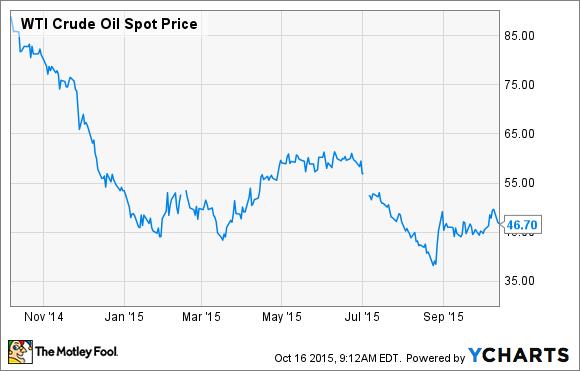
Source: Hess Corp.
It was roughly one year ago when reports surfaced that Occidental Petroleum Corporation (OXY -0.21%) was seeking a buyer for its Bakken Shale assets. At that time, Wall Street pegged the value of those assets at as much as $3 billion. However, one year later, those same assets are reportedly being unloaded for a mere $500 million. What's important to understand about that price is the fact that it is not the result of a fire sale by a company in desperate need for cash -- Occidental is doing just fine -- nor is it due to a huge disconnect in the M&A market. Instead, the low reported sales price boils down to two things: poor timing and a less-than-ideal location.
Once upon a time
When Occidental Petroleum first put its North Dakota oil assets on the market, it was right around what, in hindsight, was the peak of the oil boom. Oil prices had just started to slip after global demand growth was coming in less than expected. That, combined with a portfolio review, led Occidental to put its more than 300,000 acres up for sale. The company had already decided the position wasn't a core asset since its drilling returns weren't as high as what its rivals in the area were seeing, and that's when oil was much higher. Nor were its returns comparable with what the company could earn elsewhere, particularly in its core Permian Basin acreage. Some of that was due to company-specific issues, and some was due to location, which I'll get into in a moment.
All of that being said, by the time the company put its assets on the market in early October, the oil market had already started its decent. So, assets that might have been worth $3 billion in an $85 oil world saw that value quickly erode when oil did this:
WTI Crude Oil Spot Price data by YCharts.
Location, location, location
Compounding the problem is the location of Occidental Petroleum's acreage in the Bakken Shale play. Most of its acreage is located in Stark and Dunn counties, which are farther south from the real oil-rich counties. What is vitally important to understand, here, is that there simply isn't as much oil in the rocks underneath Occidental's acreage as there is underneath the acreage of other producers. This leads to a lower production rate and less cumulative production per well, which has a huge impact on drilling returns.
Without the premier location, Occidental Petroleum was starting at a disadvantage to Bakken peers like Hess (HES 0.82%), which has a premier position in that play.

Source: Hess Corp Investor Presentation.
In Hess' case, what matters isn't the fact that it has twice as large a position as Occidental in the play, but that the bulk of its position is in the oil-rich core of the play centered in Williams, Mountrail, and McKenzie counties. The better rock quality, when combined with Hess' lower costs due to its Lean manufacturing process and its advantaged midstream position, yields much higher drilling returns, even at the current oil price.
In other words, Occidental Petroleum's acreage position is worth a lot less for the mere reason that it is not in the oil-rich core of the play. Further, when that less-than-ideal location is combined with Occidental's higher drilling costs, as well as the fact that it doesn't have the midstream assets in the region that Hess has, the value of the play eroded quickly once oil prices headed south.
Investor takeaway
Some will suggest the Occidental Petroleum sale is a bad omen for M&A in the oil market since its assets fetched one-sixth of the initial estimated value. However, the fact of the matter is, the timing of the sale wasn't ideal because the sale process kicked off when oil was just starting its decent. Further, Occidental's assets aren't in the core of the play, which is a huge competitive disadvantage. Location really matters; it is why Hess is fueling strong growth from the Bakken, and Occidental could not.
The key takeaway, here, is to understand the context of the sale before drawing any industrywide conclusions, because the headline number could be really deceiving.






